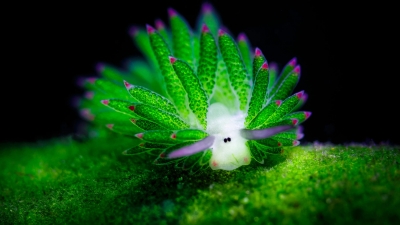
The leaf sheep, a species of sea slug, is the only non-plant organism in the world that performs photosynthesis.
Costasiella kuroshimae grows up to 8 mm in length, and is found near Japan, Indonesia and the Philippines. Its appearance makes it look like the cartoon sheep character Shaun the Sheep. It has two dark eyes, dotted green cerata on its body, and two rhinophores on its head with fine hairs that sense chemicals in the water, enabling it to find food sources. It spends its whole life on the algae Avrainvillea. In a process called kleptoplasty, it sucks the algae’s chloroplasts (structures within the algae’s cells that contain chlorophyll, a green photosynthetic pigment) and keeps them within its cerata, enabling it to perform photosynthesis. This ability has earned the leaf sheep the title of “solar-powered sea slug”.
Unfortunately, the leaf sheep are native to the waters around Japan, which means they’ll be hard to see for many of us. Although, in the eastern emerald elysia, another sea slug belonging to the clade, Sacoglossa, resides along the east coast of the U.S. The eastern emerald elysia, like the leaf sheep, can perform photosynthesize light into food. Although it’s not nearly as cute.
Picture Credit : Google
Leave a Reply